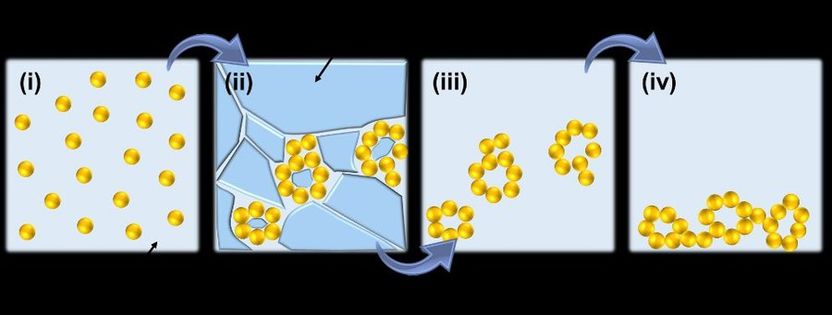Noble Metal Aerogels Enabled by Freezing
Multi-Scale Structured Materials for Electrocatalysis and Photoelectrocatalysis
TU Dresden chemists developed a freeze-thaw method, capable of synthesising various noble metal aerogels (NMAs) with clean surfaces and multiscale structure. In virtue of their hierarchical structures and unique optical properties, outstanding performance for electro-oxidation of ethanol is found. The research provides new ideas for designing various gel or foam materials for high-performance electrocatalysis and photoelectrocatalysis.

Schematic presentation of the freeze-thaw method.
TU Dresden
As a new class of porous materials, noble metal aerogels (NMAs) have drawn tremendous attention because of their combined features including self-supported architectures, high surface areas, and numerous optically and catalytically active sites, enabling their impressive performance in diverse fields. However, current fabrication methods suffer from long fabrication periods, unavoidable impurities, and uncontrolled multiscale structures, discouraging their fundamental and application-orientated studies.
Dr. Ran Du from China has been an Alexander von Humboldt research fellow at TU Dresden since 2017. In collaboration with the Dresden chemists Dr. Jan-Ole Joswig and Professor Alexander Eychmüller, they recently crafted a novel freeze-thaw method capable of acquiring various multi-scale structured noble metal aerogels as superior photoelectrocatalysts for electro-oxidation of ethanol, promoting the application for fuel cells. Their work has now been published as cover story in the prestigious journal Angewandte Chemie International Edition.
Ran Du and his team have found unusual self-healing properties of noble metal gels in their previous works. Inspired by this fact, a freeze-thaw method was developed as an additive-free approach to directly destabilise various dilute metal nanoparticle solutions (concentration of 0.2-0.5 mM). Upon freezing, large aggregates were generated due to the intensified salting-out effects incurred by the dramatically raised local solute concentration; meanwhile, they were shaped at micrometer scale by in situ formed ice crystals. After thawing, aggregates settled down and assembled to monolithic hydrogels as a result of their self-healing properties. Purified and dried, clean hydrogels and the corresponding aerogels were obtained.
Due to the hierarchically porous structures, the cleanliness, and the combined catalytic/optical properties, the resulting gold-palladium (Au-Pd) aerogels were found to display impressive light-driven photoelectrocatalytic performance, delivering a current density of up to 6.5 times higher than that of commercial palladium-on-carbon (Pd/C) for the ethanol oxidation reaction.
“The current work provides a new idea to create clean and hierarchically structured gel materials directly from dilute precursor solutions, and it should adapt to various material systems for enhanced application performance for catalysis and beyond”, assumes chemist Ran Du.
Original publication
Other news from the department science

Get the chemical industry in your inbox
By submitting this form you agree that LUMITOS AG will send you the newsletter(s) selected above by email. Your data will not be passed on to third parties. Your data will be stored and processed in accordance with our data protection regulations. LUMITOS may contact you by email for the purpose of advertising or market and opinion surveys. You can revoke your consent at any time without giving reasons to LUMITOS AG, Ernst-Augustin-Str. 2, 12489 Berlin, Germany or by e-mail at revoke@lumitos.com with effect for the future. In addition, each email contains a link to unsubscribe from the corresponding newsletter.



























































